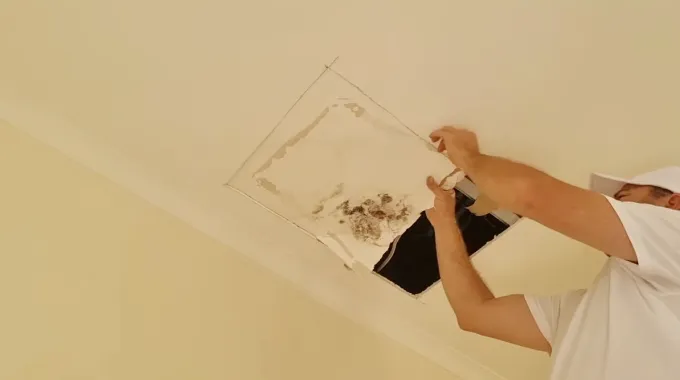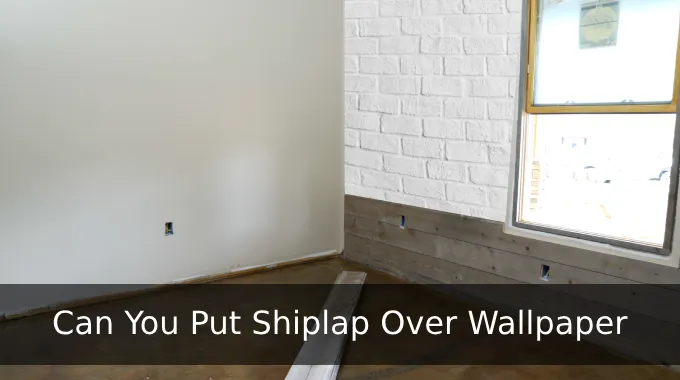Last Updated on March 13, 2023
Mold is an unwelcome houseguest that can take up residence anywhere, from basements to attics to bathrooms. Ever wondered how fast mold can grow? Within 24-48 hours, the dreaded fuzz could take over your drywall.
Growing mold can be a pesky problem both for your home’s structure and health. Unwanted mold growth creeps in with high humidity, low temperatures, water damage, or subpar construction can be a challenge.
To keep them from spreading further and worsening your wall woes, identify exactly what type of molds are present so that appropriate action may be taken. Let’s uncover the mysteries of mold on drywall, what causes its proliferation and how to take action if you notice it starting to spread?
How Long Does It Take Mold to Grow On Drywall: Reasons
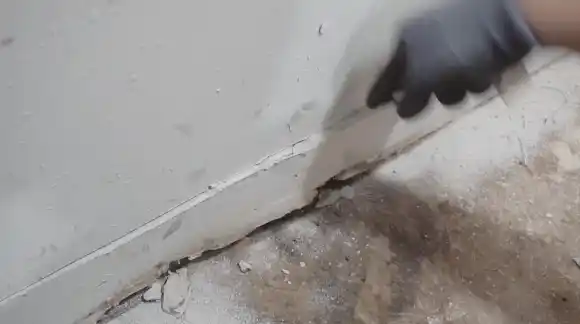
Mold growth on drywall presents an issue that many homeowners face. It can be caused by numerous factors, including high humidity, low temperature, water damage, inadequate insulation, poor ventilation and poor building construction.
1. High Humidity and Low Temperature:
High levels of humidity are one of the most common causes of mold growth on drywall. The high moisture content in the air allows for the proliferation of mold spores as they stick to wet surfaces like drywall.
In high humidity spaces, condensation on walls can create a perfect environment for mold spores to land and start growing. Condensation is created when warm, humid air comes into contact with cooler surfaces like windows or uninsulated walls.
When condensation forms, it becomes a perfect breeding ground for mold spores which can quickly spread across your drywall if not treated immediately.
When temperatures drop below the threshold level required for mold growth, it will cause the moisture content within the wall to become trapped and form colonies of mold.

2. Water Damage:
Water damage is another major factor that results in mold growth on drywall. When pipes leak or appliances break, water seeps into walls and ceilings, creating an environment conducive to mold growth within hours of exposure to water.
Flooding is another cause of mold growth since flooding allows large amounts of moisture into a home which then sits stagnant until it is fixed or removed.
3. Inadequate Insulation and Poor Ventilation:
When insulation is inadequate, warm moist air gets trapped inside walls and ceilings, causing a humid environment that encourages mold growth.
Poor ventilation is another factor that can lead to mold growth on drywall. If there is not proper ventilation in bathrooms or kitchens where moisture accumulates quickly, it can lead to an ideal breeding ground for mold growth on drywall.
4. Poor Building Construction:
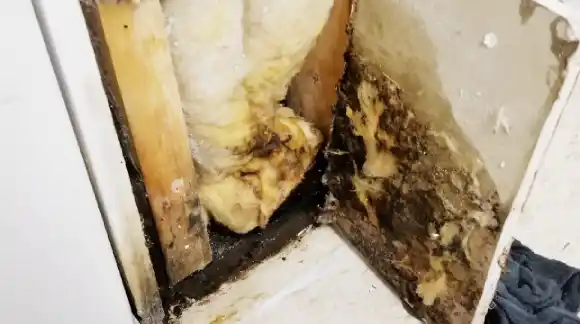
Poor building practices, such as skipping the drying process before installing interior finishes, can create a breeding ground for mold. Without proper preventive treatment, drywall surfaces become an ideal environment for molds to grow quickly and abundantly.
Additionally, improper installation of some building materials, such as wallpapers and carpets, can also cause dampness as they trap moisture inside walls leading to a damp surface that’s perfect for supporting the development of molds.
How Can You Tell if Mold is in Your Drywall?
Mold growth in drywall can cause serious health problems and damage your home. It’s important to identify the signs of mold in your drywall so that you can take steps to prevent it from getting worse. The common symptoms of mold in drywall include odor, wet and damp walls, and staining.
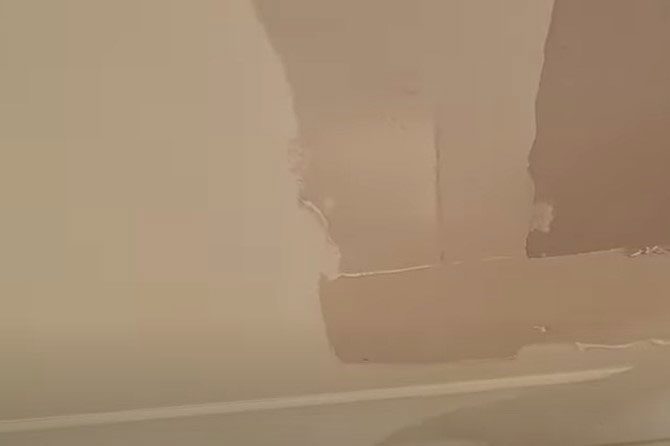
1. Odor:
A musty or damp odor is one of the most common signs of potential mold growth in drywall. This smell may be stronger when you enter a room with affected drywall or if you press on the wall itself.
You may also notice an unusual smell similar to rotting wood or paper coming from your drywall. This type of odor is often described as mildew or like wet cardboard or paper that has been left out in the rain.
The smell indicates that there is a high level of fungal spores present which can cause health risks when inhaled or ingested.
2. Wet Or Damp Drywall Wall:
If moisture is behind your drywall caused by plumbing leaks or condensation buildup, then this wet drywall could lead to hidden mold growth over time. You may see discoloration spreading across large sections of the wall or larger patches which are darker than the rest of the surface area.
Without treatment, this could eventually cause bulging, blistering, and bubbling as the water expands within the plasterboard and insulation behind the wall.
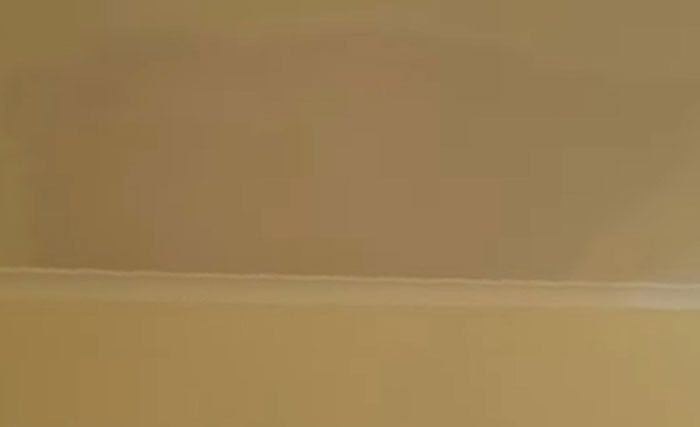
3. Health Hazardous:
People who are exposed to airborne mold spores may experience watery and red eyes, itching nose, and throat irritation. Other symptoms include sneezing, runny nose, coughing, and difficulty breathing as well as allergies such as asthma or wheezing.
In addition to these physical issues, long-term exposure to indoor mold may also lead to chronic headaches and fatigue.
Asthma sufferers should take extra caution when entering spaces where mold has been found. Mold spores can easily become airborne, potentially worsening existing respiratory conditions and making it harder to breathe comfortably.
4. Staining on Interior Walls:
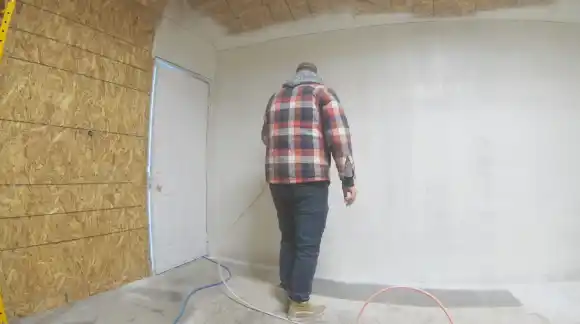
Stains on interior walls are often caused by mold growth if they are not immediately linked with other sources such as leakage or flooding.
Mold stains tend to appear as yellowish-brown patches near areas where moisture has accumulated such as windowsills or near air conditioning units. If you touch them, they might feel fuzzy or slimy.
What Types of Mold Grow on Drywall?
Mold is a type of fungus that can grow on walls, ceilings, and other surfaces in your home. It thrives in moist environments and often appears as spots of different colors. The most common types of mold found growing on drywall are black, blue, green, white, and orange.
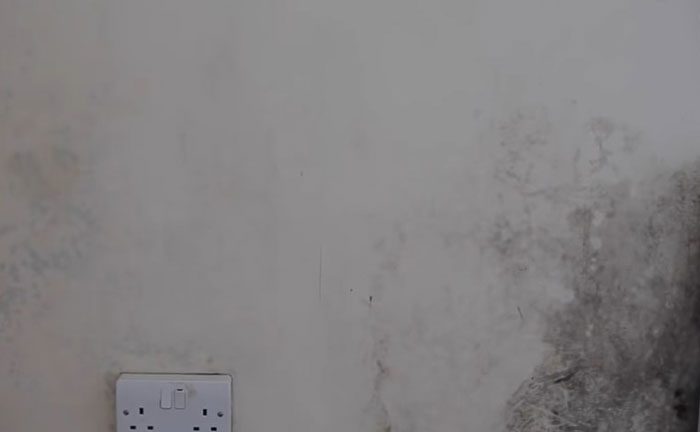
1. Black Mold (Aspergillus Mold):
Black mold is a dark-colored fungus that is commonly found on damp surfaces such as wet drywall or wood paneling. Although it is not always visible to the naked eye, you may be able to spot it by forming small circular-shaped spots on the affected area.
It can also give off a musty odor if enough growth is present. Black mold exposure should be removed as soon as possible since it can cause allergic reactions and even respiratory problems in some individuals. To get rid of black mold growth in drywall, you’ll need to cut out the impacted areas and replace them with new ones.
2. Blue Mold:
Blue mold is another fungus commonly found on wet surfaces such as drywall paneling or even damp paint on your walls or ceiling. Its color ranges from light blue to dark blue-green depending on the moisture content of the surface where it’s growing.
This type of mold needs to be taken care of immediately since it can cause headaches, allergies, and even skin irritation if exposed for too long.
3. Green Mold:
Green mold belongs to the Penicillium family, and it releases a musty odor when disturbed. It usually appears as patches or streaks with fuzzy edges that come in various shades of green (from light olive to dark olive).
If left unchecked, this type of mold may spread throughout your home very quickly, so it’s essential to take action right away if you spot any signs of green mold growth inside your house.
4. White Mold:
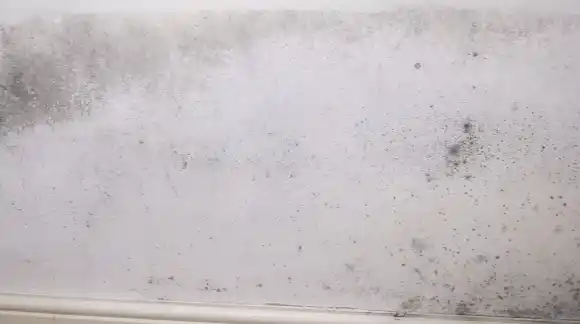
White mold is also known as powdery mildew because it appears as a white powdery substance on damp surfaces like walls or ceilings made from gypsum board (drywall). It usually forms small patches that look like cobwebs or cotton balls when viewed up close.
Although this type of mold doesn’t release toxins into the air, it should still be taken seriously because it weakens drywall over time.
5. Orange Mold (Acremonium Mold):
Orange mold belongs to the Acremonium family, and while not toxic like some other types, orange molds often indicate an even bigger problem. Water damage is caused by moisture buildup inside your house or attic space due to poor ventilation/air circulation etc.
Acremonium molds appear as brightly colored circular spots usually located near windows or doorways where humidity levels are higher than usual inside your house/building space etc.
Therefore, if you find orange mold in your home, you need to act immediately by installing proper ventilation before the mold spreads further.
Mold Growth Areas in Your Home on Drywall
1. Basements and attics, which are generally damp, dark, and have little ventilation.
2. Bathrooms, laundry rooms, and kitchens due to steam from showers and sinks plus condensation from cooking activities.
3. Areas near windows where condensation is present due to temperature differences between indoors and outdoors.
4. Areas near pipes that may have had slow drips over time, causing decay in the wall surfaces.
How Do You Stop Mold from Spreading on Drywall?
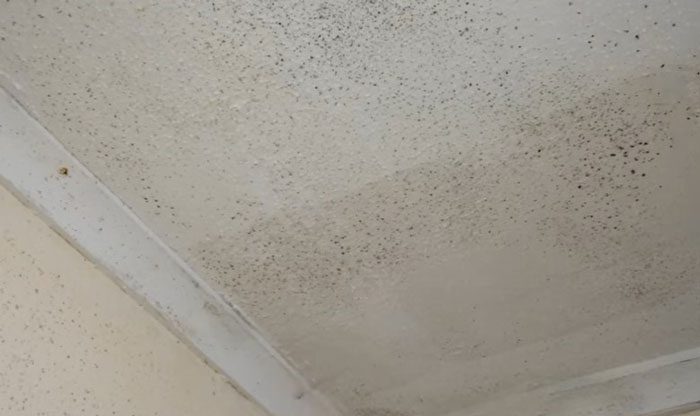
Mold growth on drywall can cause serious structural damage and health problems. Preventing mold growth is essential for the safety of the home and its occupants.
To prevent mold from spreading on drywall, it is important to reduce indoor humidity levels, thoroughly clean and disinfect areas susceptible to moisture, improve ventilation in problem areas, and install proper exhaust fans or open windows.
1. Reduce and Control Humidity by Utilizing Dehumidifiers:
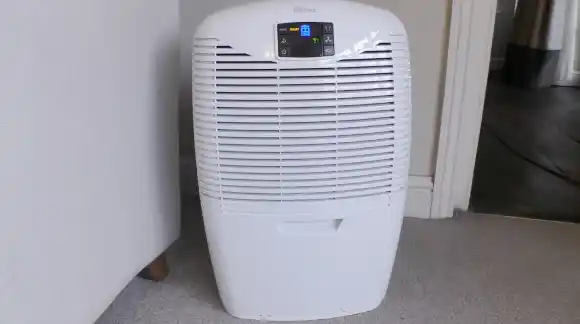
It is important to maintain humidity levels at 60 percent or lower to prevent mold growth on drywall. Investing in a dehumidifier is an effective way to reduce indoor humidity levels.
Dehumidifiers absorb moisture from the air, reducing the chances of mold spores settling onto surfaces such as walls or ceilings made of drywall. If it’s hot outside, homeowners may want to run a fan after showering or use air conditioning to reduce humidity inside.
2. Clean and Repair Disinfect Area:
In order to keep mold from growing on drywall, regular cleaning is essential. Focus on areas that are typically prone to moisture, such as windowsills, sinks, and shower tubs. Be sure to keep gutters clear of debris, so water drains properly away from the house foundation.
Furthermore, repair any existing leaks or flood damage quickly before they become a breeding ground for mold spores. Seal any cracks or gaps in the walls with caulk or weatherstripping around doors and windows, as this will protect against infiltration of outside moisture into your home.
3. Improve Ventilation In Areas Prone To Moisture:
Improving ventilation can also help reduce the chances of mold growth on drywall by allowing moist air to escape more easily from inside a house. Install exhaust fans in bathrooms and laundry rooms where there’s more moisture than in other parts of the house because you’re constantly bathing and washing clothes.
Also, opening windows during hot days will help bring fresh air into your home and let stale air with excess moisture out, so mold doesn’t grow on your drywall walls.
How to Treat Existing Mold Growth on Drywall?
The growth of mold on drywall is a common problem. It can damage the structure of a building and cause health problems, so you should remove existing mold growth on drywall.
1. Use Mold Cleaning Product:
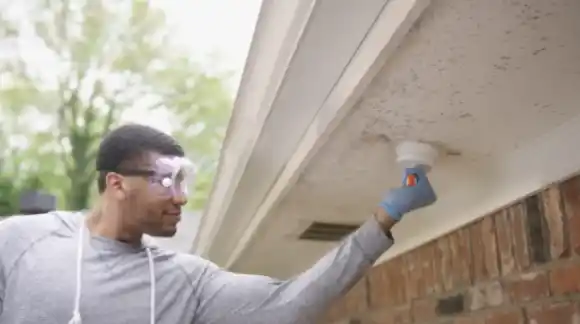
There are plenty of commercial cleaning products available specifically designed for mold removal from drywall. These products usually contain chemicals or other ingredients that break down the mold’s cellular structure and help to prevent future growth.
Some products can also be used in combination with a wet vacuum cleaner to help completely remove mold from surfaces such as walls, wood floors, and furniture.
If you decide to use a product like this, make sure you follow the instructions carefully. Wearing protective clothing such as gloves, goggles, and masks when handling these products is also advised.
2. Apply Encapsulation Techniques:
Encapsulation is a process where an encapsulating material is applied over existing areas with visible mold growth on drywall surfaces. This technique helps seal in spores so that they cannot spread into other areas of the home or building, preventing further damage.
3. Removal by Professional Contractors:
In some cases, it may be necessary to hire a professional contractor to assess the extent of the mold damage and provide removal services. Professionals will use specialized equipment and techniques to locate and remove all traces of mold from the area.
If there are high levels of mold present, they may need to remove part of the wall or ceiling for complete remediation.
4. Testing Before and After Removal/Treatment Process:
Testing before and after removing or treating existing mold growth is essential in order to ensure that all traces of the fungus have been eliminated completely. Homeowners or professionals should use air quality equipment such as air sampling pumps or spore traps to conduct mold testing.
This equipment will allow them to know if additional actions need to be taken in order to eradicate any remaining spores from the area fully. Additionally, post-treatment testing helps identify any sources of ongoing moisture that could allow new colonies to form in previously treated areas if left unchecked.
Can Mold Inside a Drywall Hurt You?
Yes, mold inside drywall can be harmful to your health. Mold spores and mycotoxins can cause an array of health issues ranging from mild allergic symptoms such as sneezing, coughing, and watery eyes to more serious asthma attacks, sinus infections, and other respiratory problems.
Long-term exposure to mycotoxins from mold can cause neurological damage in some cases. If you suspect that you may have dampness in your drywall, it’s important to get it tested by a professional and take the necessary mold remediation steps to ensure your safety.
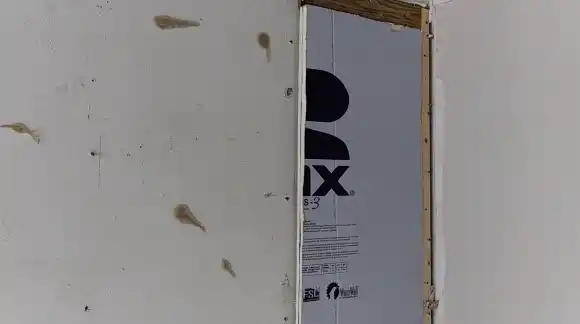
What Does Toxic Mold Look Like On Dry Walls?
Toxic mold on drywalls typically looks like a discolored patch or streak with a grayish, soot-like texture or a slimy on the wet surface. Toxic mold may also appear as black spots or fuzzy white patches along the walls or ceiling and have an earthy, musty odor when present in large amounts.
Should You Replace Drywall If It Has Mold?
If you spot major signs, it’s probably best to replace the section entirely. But, if small amounts crop up try cleaning with bleach or another chemical cleaner.
Do Dehumidifiers Remove Mold From Drywall?
Mold infestation doesn’t necessarily go away with dehumidifiers, but they can help prevent new growth by reducing indoor humidity levels. Also, combat pesky condensation and discourage new mold growths with a trusty dehumidifier.
Protect Your Home from Mold Growth on Drywall
Mold growth on drywall is a common issue in many homes due to various factors, including high humidity, water damage, and poor building construction. If left unchecked, mold can spread quickly and cause significant damage.
To prevent this from happening, it’s important to recognize the signs of mold growth, such as odors or wet/damp walls, and understand how long it takes for the fungi to grow on your drywall (24-48 hours).
Knowing the types of molds that are present is also essential in order to stop them from spreading further. Take action right away by treating existing mold growth with specialized products or calling a professional for help if needed.
